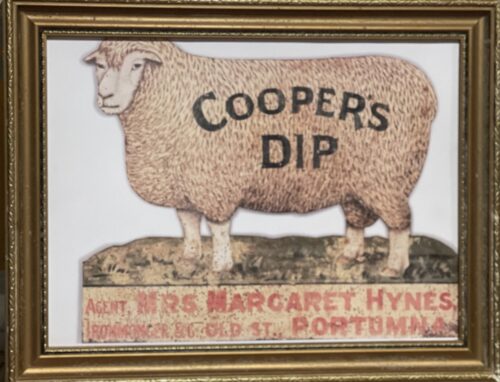-

 30cm x 39cm. Gort Co Galway Terry Willers was a famous cartoonist and animator.Born in England in 1935 he later moved to Co Wicklow and worked extensively for the Irish Times and other publications and magazines and also on RTE. In 1992 he founded the Guinness International Cartoon Festival in Rathdrum Co Wicklow. He also won the Jacobs award for his work in Television. He died in 2011. Guinness were an original sponsor of the Galway International Oyster Festival . The Galway International Oyster Festival is a food festival held annually in Galway on the west coast of Ireland on the last weekend of September, the first month of the oyster season. Inaugurated in 1954, it was the brainchild of the Great Southern Hotel (now Hotel Meyrick) manager, Brian Collins. In 2000 was described by the Sunday Times as "one of the 12 greatest shows on earth" and was listed in the 1987 AA Travel Guide as one of Europe's Seven Best Festivals. The Galway International Oyster Festival was created to celebrate the Galway Native Oyster as it is a unique feature of Galway City & County. Hotel Manager, Brian Collins had been searching for something unique to attract more visitors to Galway in what was then, a quieter month of the year. Collins discussed the idea with the folk at Guinness and Patrick M. Burke's Bar in Clarenbridge and the first Galway Oyster Festival was created in 1954 with a whole 34 attendees. The festival was originally held in Clarenbridge village during the day and the Great Southern Hotel in Galway City at night until the mid-1980s when it grew so large, all of the festivities were held in the city centre of Galway. There was a red & white striped marquee at Spanish Arch and then at Nimmo's Pier by the Claddagh. In order to reduce ticket prices, the festival changed location to The Radisson Hotel Galway in 2009 but due to popular demand, the marquee was brought back in 2011, located in the Docks and the festival was renamed as the Galway International Oyster & Seafood Festival. In 2014, the 60th anniversary of the event, its producers, Milestone Inventive, brought it back to its original Galway City home at the aptly named Fishmarket at the Spanish Arch. The main events are two Oyster Opening Championships, the Irish Oyster Opening Championship and the World Oyster Opening Championship.Other events include a Masquerade Gala 'Mardi-Gras', a seafood trail, a silent disco and a family day featuring everything from cookery demonstrations, to jazz, to circus skills workshops.
30cm x 39cm. Gort Co Galway Terry Willers was a famous cartoonist and animator.Born in England in 1935 he later moved to Co Wicklow and worked extensively for the Irish Times and other publications and magazines and also on RTE. In 1992 he founded the Guinness International Cartoon Festival in Rathdrum Co Wicklow. He also won the Jacobs award for his work in Television. He died in 2011. Guinness were an original sponsor of the Galway International Oyster Festival . The Galway International Oyster Festival is a food festival held annually in Galway on the west coast of Ireland on the last weekend of September, the first month of the oyster season. Inaugurated in 1954, it was the brainchild of the Great Southern Hotel (now Hotel Meyrick) manager, Brian Collins. In 2000 was described by the Sunday Times as "one of the 12 greatest shows on earth" and was listed in the 1987 AA Travel Guide as one of Europe's Seven Best Festivals. The Galway International Oyster Festival was created to celebrate the Galway Native Oyster as it is a unique feature of Galway City & County. Hotel Manager, Brian Collins had been searching for something unique to attract more visitors to Galway in what was then, a quieter month of the year. Collins discussed the idea with the folk at Guinness and Patrick M. Burke's Bar in Clarenbridge and the first Galway Oyster Festival was created in 1954 with a whole 34 attendees. The festival was originally held in Clarenbridge village during the day and the Great Southern Hotel in Galway City at night until the mid-1980s when it grew so large, all of the festivities were held in the city centre of Galway. There was a red & white striped marquee at Spanish Arch and then at Nimmo's Pier by the Claddagh. In order to reduce ticket prices, the festival changed location to The Radisson Hotel Galway in 2009 but due to popular demand, the marquee was brought back in 2011, located in the Docks and the festival was renamed as the Galway International Oyster & Seafood Festival. In 2014, the 60th anniversary of the event, its producers, Milestone Inventive, brought it back to its original Galway City home at the aptly named Fishmarket at the Spanish Arch. The main events are two Oyster Opening Championships, the Irish Oyster Opening Championship and the World Oyster Opening Championship.Other events include a Masquerade Gala 'Mardi-Gras', a seafood trail, a silent disco and a family day featuring everything from cookery demonstrations, to jazz, to circus skills workshops. -
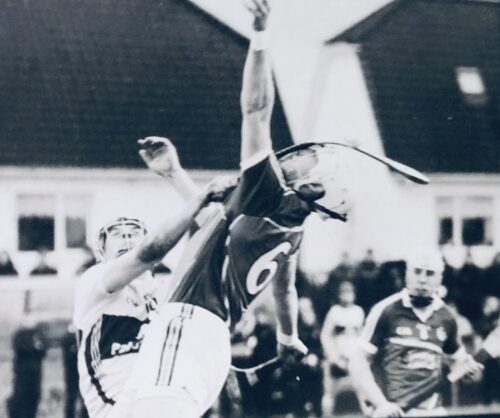
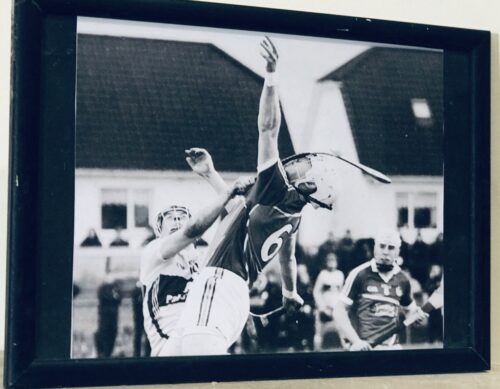 26cm x 33cm Not so much the clash of the ash as the bend of the ash in this unbelievable action photograph as Clare and Limerick Hurlers do battle in a challenge game in Sixmilebridge.The art of Hurley making & the raw materials used have not changed a lot since time immemorial as this article demonstrates ; Cad a dhéanfaimid feasta gan adhmaid, tá deireadh na gcoillte ar lár…” seems an appropriate opening to an article about hurley making, as we speak to Pat Cronin in his workshop overlooking the Comeragh Mountains in Kilcash, Tipperary. “Over 90% of the timber used in hurley-making now is foreign. Irish ash is very scarce, although Coillte are working to change this”, explained Pat. “I get most of my timber from Coillte in Dundrum (Tipperary). This comes from Denmark and Sweden”. Although some makers have produced hurleys from 14 year old ash Pat believes this is too soon. “You might only get two or three slabs out of a tree that young. If you left it another five or more years you’d get more than double that. It’d really take up to 25 years to get a decent return.” Pat’s uncle, Larry Welsh, made hurleys, but Pat didn’t realise this when he started out. “John Joe O’Brien in Cahir taught me. I used to call to him to get a few now and then and it went from there. I started about 25 years ago and gave up working with Eircom to go at it full time five years ago. I’m kept busy throughout the year.” Brian Dowling’s “Star Hurleys” workshop is in the heart of Kilkenny. Despite the fact that his son Mark is also in the business they’re under constant pressure to meet demand. Brian, who served his time to become a carpenter, has been making hurleys since 1980. His father Ramie was a well known maker, who started in the early 1960’s with Brian’s grandfather Tom Neary. It probably takes about thirty minutes to make a hurley, if you were to go at it from start to finish. However, neither Pat nor Brian make them in this way. Both use copying machines to rough cut “slabs” three or four at a time. Each then finishes the hurleys by hand, to meet specific requirements. “You get phases of popularity in styles”, explained Pat Cronin, “Because of the O’Connor’s of Cork for instance, big bosses are in favour now. But there’s also a trend towards shorter and lighter sticks. There’s a risk if the hurley is too light it’ll snap more easily. And you don’t get the same distance on a puck out.” Brian, recently in Italy looking at a replacement for his aging copying machine, only cuts 33 inch sticks and bigger this way. “I do the smaller ones entirely by hand”. The style of hurling has changed over the years and naturally the hurley changes to reflect this. “Demands for particular styles naturally reflect the styles of the successful teams of the time”. Certainly the demand for personalised sticks has grown. Brian, who supplies most of the Kilkenny senior team, explains that most of them have specific demands. Every hurley maker will advise you differently about how best to look after your stick! wever, you need good quality timber to start with. Pat Cronin suggests that when you get your new hurley you should put it away for a while. “Some people hang them, rather than prop them against a wall, so they won’t warp. There are those who put them in water until they get the right weight. Then they’ll varnish or linseed oil them to keep them at that weight. Like a good wine it should also be stored somewhere cool! You definitely shouldn’t keep them in the kitchen or in the boot of your car, or they will dry out.” Brian suggests that it’s better to buy the stick unbanded. “You need to allow a bit of time for timber to settle. You might also put five or six coats of linseed oil on, or even drop them into a barrel of linseed oil for a while, to get more penetration. You have to remember that this will add weight ‘though. But whether you oil them or not, you should leave them for a good week or so before banding them. And don’t keep them in the house!” There is a Hurley Makers Guild, which was formed almost ten years ago when ash became scarce. Makers felt the need to organise themselves to address the problem. There are about fifty active members these days. Both Pat Cronin and Brian Dowling are curious to see how Jack Carey – brother of the illustrious DJ – gets on with his plan to import finished hurleys from Eastern Europe. This could have quite an impact on what might be regarded as a quintessentially Irish cottage industry. However, time will tell. Just to set up a workshop and kit it out here in Ireland would probably cost about half a million Euro, according to both Pat and Brian. Not a cheap business to get into! Little wonder the notion of foreign manufactured hurleys doesn’t seem that strange… Two great Craftsmen, continuing the wonderful tradition of hurley-making.
26cm x 33cm Not so much the clash of the ash as the bend of the ash in this unbelievable action photograph as Clare and Limerick Hurlers do battle in a challenge game in Sixmilebridge.The art of Hurley making & the raw materials used have not changed a lot since time immemorial as this article demonstrates ; Cad a dhéanfaimid feasta gan adhmaid, tá deireadh na gcoillte ar lár…” seems an appropriate opening to an article about hurley making, as we speak to Pat Cronin in his workshop overlooking the Comeragh Mountains in Kilcash, Tipperary. “Over 90% of the timber used in hurley-making now is foreign. Irish ash is very scarce, although Coillte are working to change this”, explained Pat. “I get most of my timber from Coillte in Dundrum (Tipperary). This comes from Denmark and Sweden”. Although some makers have produced hurleys from 14 year old ash Pat believes this is too soon. “You might only get two or three slabs out of a tree that young. If you left it another five or more years you’d get more than double that. It’d really take up to 25 years to get a decent return.” Pat’s uncle, Larry Welsh, made hurleys, but Pat didn’t realise this when he started out. “John Joe O’Brien in Cahir taught me. I used to call to him to get a few now and then and it went from there. I started about 25 years ago and gave up working with Eircom to go at it full time five years ago. I’m kept busy throughout the year.” Brian Dowling’s “Star Hurleys” workshop is in the heart of Kilkenny. Despite the fact that his son Mark is also in the business they’re under constant pressure to meet demand. Brian, who served his time to become a carpenter, has been making hurleys since 1980. His father Ramie was a well known maker, who started in the early 1960’s with Brian’s grandfather Tom Neary. It probably takes about thirty minutes to make a hurley, if you were to go at it from start to finish. However, neither Pat nor Brian make them in this way. Both use copying machines to rough cut “slabs” three or four at a time. Each then finishes the hurleys by hand, to meet specific requirements. “You get phases of popularity in styles”, explained Pat Cronin, “Because of the O’Connor’s of Cork for instance, big bosses are in favour now. But there’s also a trend towards shorter and lighter sticks. There’s a risk if the hurley is too light it’ll snap more easily. And you don’t get the same distance on a puck out.” Brian, recently in Italy looking at a replacement for his aging copying machine, only cuts 33 inch sticks and bigger this way. “I do the smaller ones entirely by hand”. The style of hurling has changed over the years and naturally the hurley changes to reflect this. “Demands for particular styles naturally reflect the styles of the successful teams of the time”. Certainly the demand for personalised sticks has grown. Brian, who supplies most of the Kilkenny senior team, explains that most of them have specific demands. Every hurley maker will advise you differently about how best to look after your stick! wever, you need good quality timber to start with. Pat Cronin suggests that when you get your new hurley you should put it away for a while. “Some people hang them, rather than prop them against a wall, so they won’t warp. There are those who put them in water until they get the right weight. Then they’ll varnish or linseed oil them to keep them at that weight. Like a good wine it should also be stored somewhere cool! You definitely shouldn’t keep them in the kitchen or in the boot of your car, or they will dry out.” Brian suggests that it’s better to buy the stick unbanded. “You need to allow a bit of time for timber to settle. You might also put five or six coats of linseed oil on, or even drop them into a barrel of linseed oil for a while, to get more penetration. You have to remember that this will add weight ‘though. But whether you oil them or not, you should leave them for a good week or so before banding them. And don’t keep them in the house!” There is a Hurley Makers Guild, which was formed almost ten years ago when ash became scarce. Makers felt the need to organise themselves to address the problem. There are about fifty active members these days. Both Pat Cronin and Brian Dowling are curious to see how Jack Carey – brother of the illustrious DJ – gets on with his plan to import finished hurleys from Eastern Europe. This could have quite an impact on what might be regarded as a quintessentially Irish cottage industry. However, time will tell. Just to set up a workshop and kit it out here in Ireland would probably cost about half a million Euro, according to both Pat and Brian. Not a cheap business to get into! Little wonder the notion of foreign manufactured hurleys doesn’t seem that strange… Two great Craftsmen, continuing the wonderful tradition of hurley-making. -
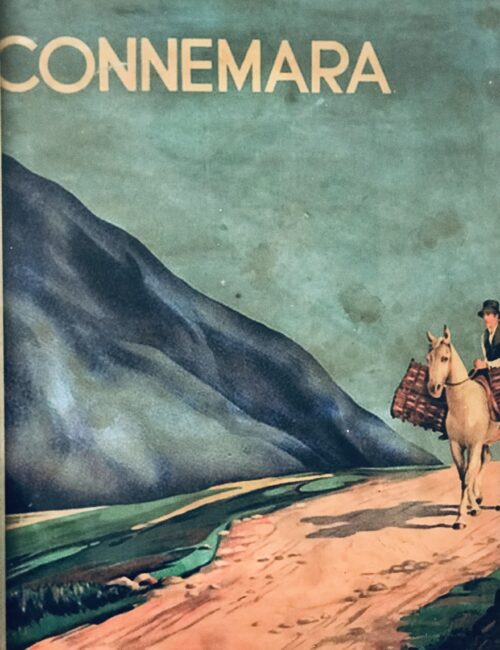
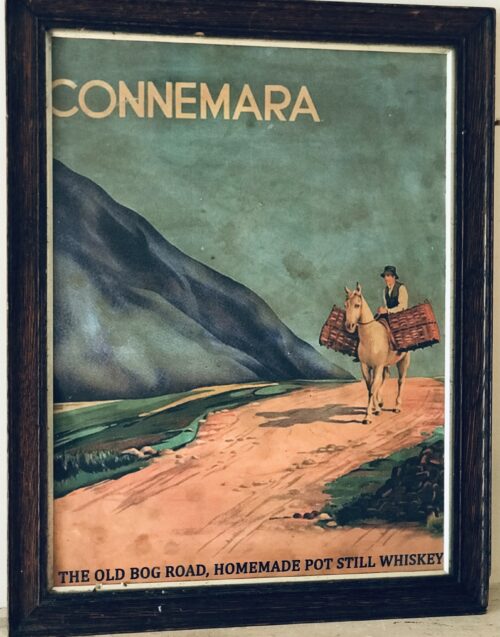 Highly unusual Connemara The Old Bog Road Homemade Pot Still Whiskey Advert. 60cm x 47cm Clifden Co Galway Because of the dearth of information surrounding this advert, we suspect that this advert may have been a cover for a poitín distilling operation perhaps, whose spiritual home and epicentre would have been in Connemara and the West of Ireland. Poitín is actually our national drink - not the black stuff of corporations or the mass-produced whiskey of the clubhouse elite. It came before them, it came from us. A magical white spirit, it belonged to every man and woman. Before whiskey there was poitín. Poitín is Ireland’s original spirit and the precursor to modern-day whiskey, with a rich history and an irreverent past. Banned for over 200 years by a foreign parliament, poitín was considered by most to be a vastly superior product to the mass-produced legal whiskeys, or ‘parliament whiskeys’, made by the large manufacturers. To quote the Irish writer and clergyman Caesar Otway – “To every Irishman poitín is superior in sweetness, salubriety and gusto, to all that machinery, science and capital can produce in the legalised way”. The word ‘poitín’ comes from the Irish word for a pot, ‘pota’. This refers to the small pot-still commonly used by poitín distillers. Being caught with a poitín still by the excise men, sometimes accompanied by the British army, would mean a hefty fine or time spent in jail. Traditionally poitín was distilled from malted grains such as barley, oats, wheat and occasionally rye. Only relatively recently was poitín made from alternative ingredients such as potatoes, whey, beets or sugar. The highest quality poitín is still that made from grain alone. The traditional drink at Irish wakes, funerals, weddings and fairs, poitín is also renowned for its medicinal properties. A hot poitín is still considered by many to be the best way to get rid of a cold or flu. Poitín is also rumoured to be a remedy for impotence, as well as a powerful aphrodisiac. Thankfully, poitín is now legal again (since 1997), after a 200 year ‘hiatus’. It enjoys Geographical Indicative Protection from the European Union, and may only be produced on the island of Ireland.
Highly unusual Connemara The Old Bog Road Homemade Pot Still Whiskey Advert. 60cm x 47cm Clifden Co Galway Because of the dearth of information surrounding this advert, we suspect that this advert may have been a cover for a poitín distilling operation perhaps, whose spiritual home and epicentre would have been in Connemara and the West of Ireland. Poitín is actually our national drink - not the black stuff of corporations or the mass-produced whiskey of the clubhouse elite. It came before them, it came from us. A magical white spirit, it belonged to every man and woman. Before whiskey there was poitín. Poitín is Ireland’s original spirit and the precursor to modern-day whiskey, with a rich history and an irreverent past. Banned for over 200 years by a foreign parliament, poitín was considered by most to be a vastly superior product to the mass-produced legal whiskeys, or ‘parliament whiskeys’, made by the large manufacturers. To quote the Irish writer and clergyman Caesar Otway – “To every Irishman poitín is superior in sweetness, salubriety and gusto, to all that machinery, science and capital can produce in the legalised way”. The word ‘poitín’ comes from the Irish word for a pot, ‘pota’. This refers to the small pot-still commonly used by poitín distillers. Being caught with a poitín still by the excise men, sometimes accompanied by the British army, would mean a hefty fine or time spent in jail. Traditionally poitín was distilled from malted grains such as barley, oats, wheat and occasionally rye. Only relatively recently was poitín made from alternative ingredients such as potatoes, whey, beets or sugar. The highest quality poitín is still that made from grain alone. The traditional drink at Irish wakes, funerals, weddings and fairs, poitín is also renowned for its medicinal properties. A hot poitín is still considered by many to be the best way to get rid of a cold or flu. Poitín is also rumoured to be a remedy for impotence, as well as a powerful aphrodisiac. Thankfully, poitín is now legal again (since 1997), after a 200 year ‘hiatus’. It enjoys Geographical Indicative Protection from the European Union, and may only be produced on the island of Ireland. -

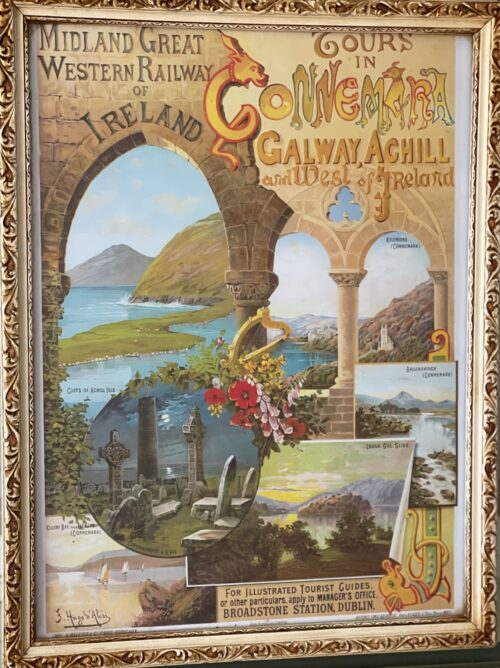 45cm x 34cm The Midland Great Western Railway (MGWR) was the third largest Irish gauge (1,600 mm (5 ft 3 in)) railway company in Ireland. It was incorporated in 1845 and absorbed into the Great Southern Railways in 1924. At its peak the MGWR had a network of 538 miles (866 km), making it Ireland's third largest network after the Great Southern and Western Railway(GS&WR) and the Great Northern Railway of Ireland. The MGWR served part of Leinster, County Cavan in Ulster and much of Connacht. Its network was entirely within what in 1922 became the Irish Free State.
45cm x 34cm The Midland Great Western Railway (MGWR) was the third largest Irish gauge (1,600 mm (5 ft 3 in)) railway company in Ireland. It was incorporated in 1845 and absorbed into the Great Southern Railways in 1924. At its peak the MGWR had a network of 538 miles (866 km), making it Ireland's third largest network after the Great Southern and Western Railway(GS&WR) and the Great Northern Railway of Ireland. The MGWR served part of Leinster, County Cavan in Ulster and much of Connacht. Its network was entirely within what in 1922 became the Irish Free State.Early development
The Midland Great Western Railway Act received the Royal Assent in July 1845, authorising it to raise £1,000,000 capitaland to build a railway from Dublin to Mullingar and Longford and to buy the Royal Canal. Construction of the main line began from Dublin in January 1846 and proceeded westwards in stages, supervised by chief engineer G. W. Hemans. It opened from Dublin Broadstoneas far as Enfield in May 1847,to Hill of Down in December 1847 and to Mullingar in October 1848Dublin to Galway
Rivalry existed between the MGWR and the GS&WR, each of which wanted to build the line to Galway. The MGWR extended its line from Mullingar and the GS&WR from its line at Portarlington. The MGWR was first, going via Athlone and reaching Galway, 126.5 miles (203.6 km) from Dublin, in August 1851.It was not until 1859 that the GS&WR got as far as Athlone. The GS&WR was obliged to operate its service over MGWR track between Athlone and Galway, paying the MGWR 65% of passenger and 55% of goods receipts. The GS&WR retained a separate station, which is now the sole operating station, as the last service to the MGWR station ran on 13 January 1985.. The branch is to be made into a rail trail as part of the Dublin-Galway Greenway by 2020.Galway to Clifden
In 1890 the Government granted the MGWR £264,000 to build a railway to Clifdenon the Atlantic coast of County Galway. It opened as far as Oughterard in January 1895 and to Clifden in July 1895.Due to its inland route it did not serve the bulk of the area's population, so the GSR closed it in 1935. A similar branch line was built at the same time from Westport to Achill on the Atlantic coast of County Mayo. The MGW built the first section, opening it as far as Newport in February 1894 and Mulranny in May 1894.The Board of Works built the section from Mulranny to Achill, which opened in May 1895.The GSR closed the line in 1937.Branch lines
At its peak the MGWR had a number of branch lines: Tunnel at Newport on the Westport to Achill branch line.
Tunnel at Newport on the Westport to Achill branch line.- Clonsilla to Navan (opened as the Dublin and Meath Railway 1862, leased to the MGWR 1869, sold to the MGWR 1888)
- extension from Navan to Kingscourt, (opened by the Navan and Kingscourt Railway 1865, sold to the MGWR 1888)
- Kilmessan Junction to Athboy (opened 1864, closed 1963)
- Nesbitt Junction (near Enfield) to Edenderry (opened 1877, closed 1963)
- Streamstown to Clara, County Offaly (opened 1863, closed 1963)
- Attymon Junction to Loughrea (light railway worked by the MGWR, opened 1890)
- Galway to Clifden (opened 1895, closed 1935)
- Westport to Achill (opened 1895, closed 1937)
- Inny Junction to Cavan Town (opened 1856, closed 1960)
- Kilfree Junction railway station to Ballaghaderreen (opened by the Sligo and Ballaghaderreen Railway 1874, sold to the MGWR 1877, closed 1963)
- Crossdoney to Killeshandra (opened 1886, closed 1960)
- Athlone to Westport (opened by the Great Northern and Western Railway 1860–66, leased to the MGWR 1870, sold to the MGWR 1890)
- Claremorris to Ballinrobe (light railway worked by the MGWR, opened 1892, closed 1960)
- Manulla to Ballina, County Mayo (opened 1873)
- extension from Ballina to Killala (opened 1893, closed 1937)
Consolidation
In 1924 the Oireachtas of the Irish Free State passed the Railways Act, which that November merged the MGWR with the Great Southern and Western Railway(GS&WR), Cork, Bandon and South Coast Railway to form the Great Southern Railway. In January 1925, that was joined by the Dublin and South Eastern Railwayto form the Great Southern Railways.Locomotives and rolling stock
Locomotives and rolling stock were maintained at MGWR's Broadstone works in Dublin.Livery
The MGWR painted all of its locomotives bright emeralduntil about 1902, when the first of the new Class A 4-4-0 express locomotives were outshopped in royal blue.This did not wear well and in 1905 the company adopted grass green. From about 1913 locos were painted gloss blackuntil the MGWR became part of the GSR in 1925. From then on, all locomotives were gradually repainted plain unlined dark grey. Passenger coaches were finished in varnish or brown paint until the blue livery was introduced in 1901. As on the locomotives this weathered badly and from 1905 the MGWR reverted to brown,which after 1910 was not so well-adorned with lining.From October 1918 coaches were painted a very dark Crimson and after 1924 the GSR used a similar shade for some years.Preservation
No MGWR locomotive has been preserved but several of its six-wheeled carriages exist.- No. 25 - Downpatrick and County Down Railway. Originally a full 2nd, this coach is on display in the carriage gallery awaiting restoration.
- No. 47 - Ulster Folk and Transport Museum. Built in 1844 and notable for being used as William Dargan's private saloon. Fully restored.
- No. 47M - This carriage used to be based at the DCDR, but unfortunately had to be scrapped.
- No. 53 - Downpatrick and County Down Railway. Originally a full 2nd, this coach is on display in the carriage gallery awaiting restoration.
- No. 62M - Railway Preservation Society of Ireland. A full 3rd, this carriage is meant to be under restoration for use at the DCDR.
- No. 84 - Clifden. Intended to be restored as part of the Station House Hotel's collection.
Present day
Those of the former MGWR's main lines that are still open are owned and operated by Iarnród Éireann. Routes between Dublin and Sligo, Athlone and Galway, Athlone and Westport and the Ballina branch remain open to passenger traffic. The Meath on Track campaign is campaigning to have the Navan — Clonsilla line (not to be confused with the former GNR Navan — Drogheda line) reopened earlier than the 2030 date announced under current Iarnród Éireann policy.The Edenderry, Clifden, Achill, Cavan, Killeshandra, Ballaghaderreen branch line, Ballinrobe, Killala and Loughrea branches lines are all closed. Rail Users Ireland proposed running some Galway — Dublin services via the MGWR station in Athlone and the disused route via Moate to Mullingar, reinstating the route of the first MGWR service via the former GS&WR line. The current Galway service runs from Dublin Heuston. This proposal will not go ahead as the railway is due to be replaced with the Dublin-Galway greenway starting from 2020. Three former MGWR stations are now hotels, two of which are called the "Station House Hotel" but are unconnected by ownership. They are the expanded former Clifden station in County Galway, Kilmessan Junction in County Meath and the Mullranny Park Hotel at Mulranny, County Mayo. The Great Western Greenway is a greenway rail trail that uses the route of the former Westport — Achill branch line. -
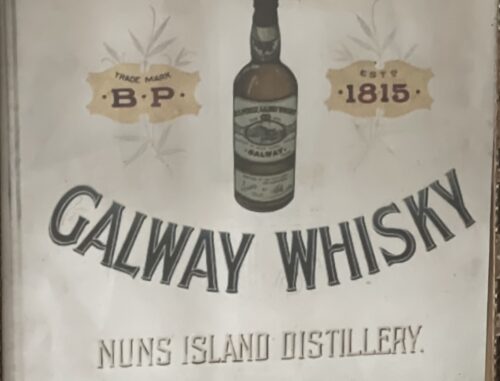
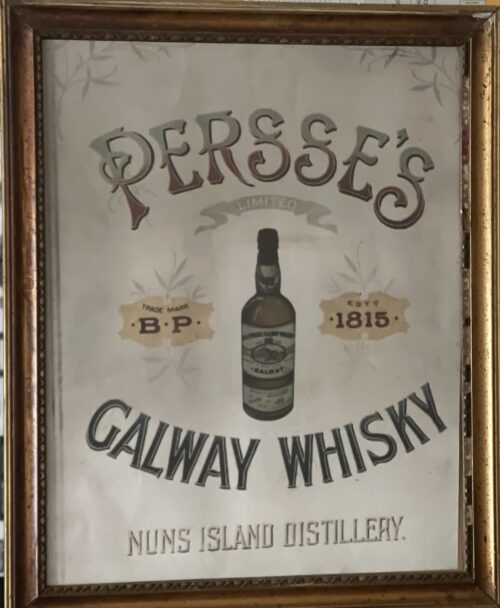 65cm x 45cm Nun's Island Distillery was an Irish whiskey distillery which operated in Galway, Ireland, from at least 1815, and possibly as early as the late 1700s, until circa 1908. At its peak, in the late 1800s, output at the distillery reached 400,000 gallons per annum, and with a workforce of over 100, the distillery was one of the largest local employers. Owned by the Persse family from the 1840s onwards, the distillery produced single pot still whiskey known as Persse's Galway Whiskey. The whiskey was sold locally in Connacht, where for much of the 1800s, Nun's Island was the only licensed distillery.However, it was also exported, and is said to have been a sold to the British House of Commons, a fact proudly noted on their labels. Production at the distillery ceased circa 1908, with the remaining stocks wound down off over several few years. A bottle of Persse's whiskey was placed for auction in 2002 with a reserve price of £100,000 - however, it failed to sell. The bottle later sold for £3,300 in 2014.
65cm x 45cm Nun's Island Distillery was an Irish whiskey distillery which operated in Galway, Ireland, from at least 1815, and possibly as early as the late 1700s, until circa 1908. At its peak, in the late 1800s, output at the distillery reached 400,000 gallons per annum, and with a workforce of over 100, the distillery was one of the largest local employers. Owned by the Persse family from the 1840s onwards, the distillery produced single pot still whiskey known as Persse's Galway Whiskey. The whiskey was sold locally in Connacht, where for much of the 1800s, Nun's Island was the only licensed distillery.However, it was also exported, and is said to have been a sold to the British House of Commons, a fact proudly noted on their labels. Production at the distillery ceased circa 1908, with the remaining stocks wound down off over several few years. A bottle of Persse's whiskey was placed for auction in 2002 with a reserve price of £100,000 - however, it failed to sell. The bottle later sold for £3,300 in 2014.History
The early history of the distillery is somewhat difficult to piece together.It is known that a distillery on Nun's Island was being operated on by a John Joyce in the late 1700s.This distillery, which was subsequently taken over by Patrick Joyce, is thought to have ceased operations in 1807. A Patrick Joyce is recorded as running a small distillery on Nun's Island again in 1823. Therefore, it is possible that the closure was temporary. By 1828, output at the distillery had increased to 130,000 proof gallons per annum. There are claims that the distillery ceased operations again in the late 1830s.However, a newspaper advertisement from 1841 reports that a distillery "lately occupied and worked" by Messrs. James and Patrick Joyce was to be sold on 4 February 1841. The advertisement noted that the distillery was held under a 300-year lease, which had commenced in August 1815.This tallies with Alfred Barnard's 1887 report that Joyce's owned the distillery from 1815 to 1840. In about 1840 or 1841, the distillery was purchased by the Persses, a local family who ran several other distilleries in the area.There is some conflicting information with regard to the precise and nature of the sale date. Barnard reported that the distillery was sold by the Encumbered Claims Courts in 1840.However, a newspaper article from the era reports that the distillery was to be sold by private contract in February 1841. As Barnard mentions that the Persses enlarged the original operation, the confusion may be due to piecemeal purchases of different sections of the site, or delays in finalising the sale as the distillery had been repeatedly advertised for sale beginning in at least early 1840. Initially the Persses converted the distillery to a woollen mill, which was known for producing excellent friezes. However, when their lease on the nearby Newcastle Distillery expired in 1846, they moved their distilling operations at the Nun's Island complex, and re-established the site as a distillery. In 1886, the distillery was visited by British historian Alfred Barnard, as recounted in his seminal publication "The Whiskey Distilleries of the United Kingdom". Barnard noted that at the time of his visit Nun's Island was the sole distillery operating in Connacht, and had an output of about 400,000 gallons per annum. In addition to offices, workshops, stables, and storehouses, the distillery buildings included two lofty Maltings and Corn stores built of stone, five storeys of which were devoted to the storing of corn, and two to malting purposes; an elegant brew house equal to any in Ireland; a back house containing thirteen washbacks, each with a capacity of about 18,000 gallons; a still house containing a 16,000 gallon wash still, a 10,000 gallon spirit still, and a 6,000 gallon low-wines still; a spirit store occupied by a 12,000 gallon vat; and five warehouses, holding a total of about 5,000 casks at the time. Like many other Irish distilleries, Nun's Island encountered financial difficulties during the early part of the 20th Century, is thought to have closed shortly before World War I. Since closing, some of the distillery complex has been demolished. However, several of the main distillery buildings, notably the large riverside warehouse, are still extant.


